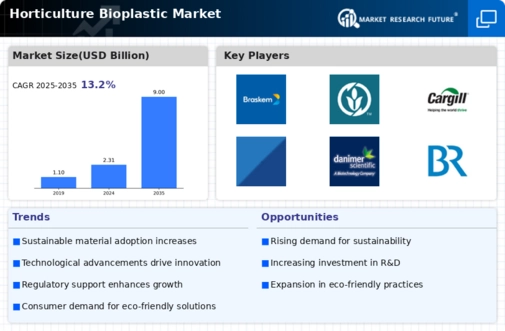Consumer Awareness
Growing consumer awareness regarding environmental issues is significantly influencing the Global Horticulture Bioplastic Market Industry. As consumers become more informed about the detrimental effects of traditional plastics, there is an increasing demand for sustainable alternatives. This shift in consumer behavior is prompting horticultural businesses to adopt bioplastics in their operations. For instance, many nurseries and garden centers are now offering bioplastic pots and trays, which appeal to environmentally conscious customers. This trend not only enhances brand reputation but also drives sales, as consumers are willing to pay a premium for sustainable products. Consequently, the market is anticipated to grow substantially in the coming years.
Market Diversification
Market diversification within the Global Horticulture Bioplastic Market Industry is emerging as a significant trend. As the demand for bioplastics grows, manufacturers are exploring various applications beyond traditional uses. This includes the development of bioplastic films, biodegradable mulch, and other innovative products tailored for horticultural needs. Such diversification not only opens new revenue streams for companies but also enhances the overall market potential. With projections indicating that the market could reach 9.0 USD Billion by 2035, the expansion into new product categories is likely to play a vital role in sustaining growth and meeting the evolving demands of consumers.
Market Growth Projections
The Global Horticulture Bioplastic Market Industry is poised for remarkable growth, with projections indicating a substantial increase in market size. By 2024, the market is expected to reach 2.31 USD Billion, and it is anticipated to expand to 9.0 USD Billion by 2035. This growth trajectory suggests a compound annual growth rate of 13.16% from 2025 to 2035, reflecting the increasing adoption of bioplastics in horticulture. The rising awareness of environmental sustainability, coupled with technological advancements and supportive government policies, is likely to drive this growth. As such, stakeholders in the horticulture sector are encouraged to explore opportunities within this burgeoning market.
Sustainability Initiatives
The Global Horticulture Bioplastic Market Industry is experiencing a surge in demand driven by increasing sustainability initiatives across various sectors. Governments worldwide are implementing stringent regulations aimed at reducing plastic waste, which has led to a growing preference for bioplastics. For instance, the European Union's commitment to a circular economy has prompted horticultural businesses to adopt bioplastics that are biodegradable and compostable. This shift not only aligns with environmental goals but also caters to consumer preferences for sustainable products. As a result, the market is projected to reach 2.31 USD Billion in 2024, reflecting a significant transition towards eco-friendly materials.
Technological Advancements
Technological advancements in bioplastic production are playing a pivotal role in the growth of the Global Horticulture Bioplastic Market Industry. Innovations in polymer science and biotechnology have led to the development of high-performance bioplastics that meet the specific needs of horticultural applications. For example, the introduction of polylactic acid (PLA) and polyhydroxyalkanoates (PHA) has enhanced the durability and functionality of bioplastics, making them suitable for various horticultural products. These advancements not only improve product performance but also reduce production costs, thereby attracting more manufacturers to enter the bioplastic market. This trend is expected to contribute to a compound annual growth rate of 13.16% from 2025 to 2035.
Government Support and Incentives
Government support and incentives are crucial drivers for the Global Horticulture Bioplastic Market Industry. Various governments are introducing policies and financial incentives to encourage the adoption of bioplastics in horticulture. For example, subsidies for bioplastic production and tax breaks for companies utilizing sustainable materials are becoming increasingly common. Such initiatives not only lower the financial barriers for businesses but also stimulate innovation in bioplastic technologies. As a result, more horticultural enterprises are likely to transition towards bioplastics, further expanding the market. This supportive regulatory environment is expected to facilitate a robust growth trajectory for the industry.























Leave a Comment